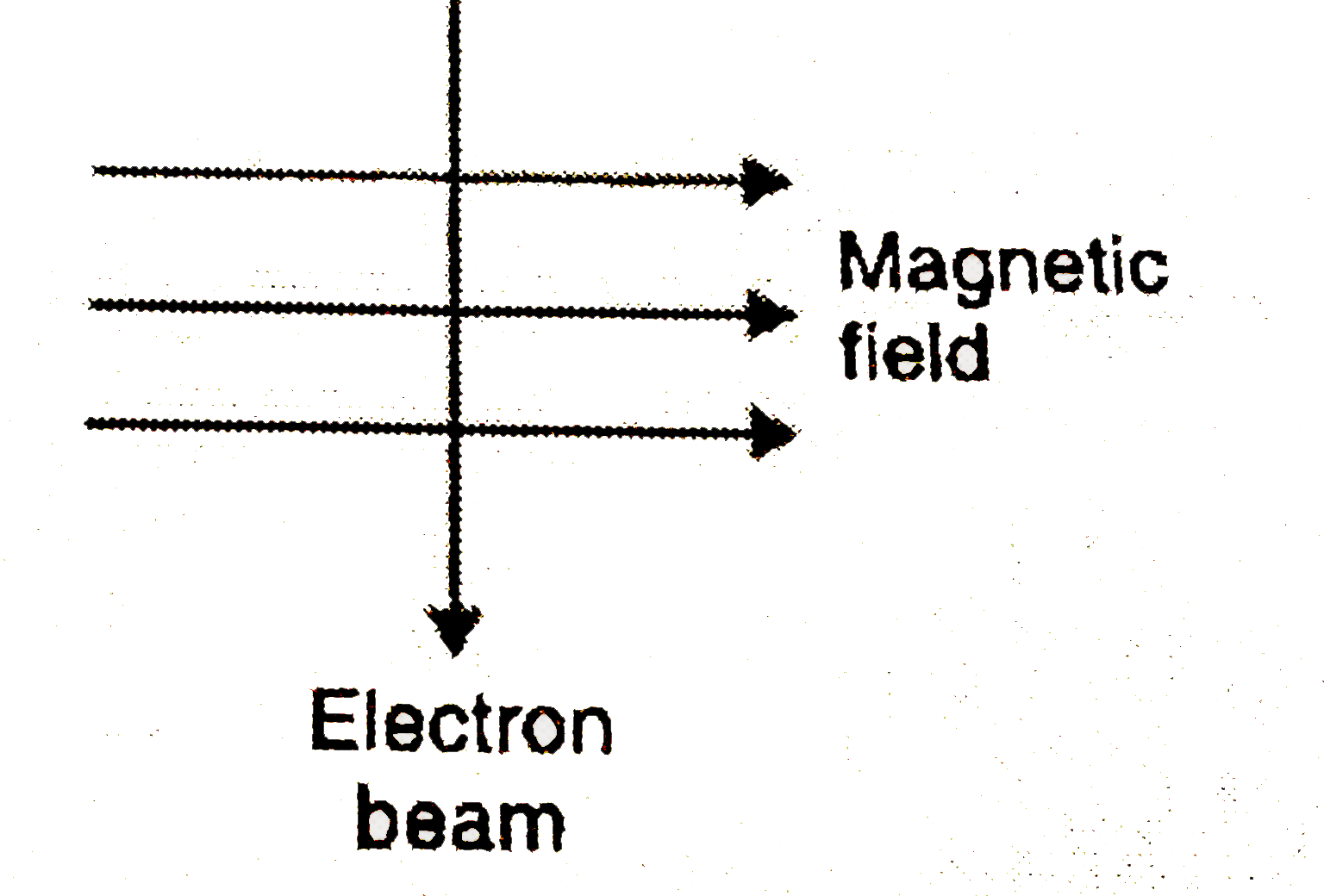A beam of electrons is under the effect of potential difference of volt applied across two parallel plates apart and a magnetic field of at right angles to each other. If these two field produces no deflection in the beam. find the velocity of electrons. What will be radius of the orbit in which the beam will move, if the electric field is made zero ? Given, Mass of electron .
The correct Answer is:
To solve the problem step by step, we will first find the velocity of the electrons and then calculate the radius of the orbit when the electric field is made zero.
Step 1: Calculate the Electric Field (E)
The electric field (E) between two parallel plates is given by the formula:
E=Vd
where:
- V=1.36×104volts (potential difference)
- d=4cm=4×10−2m (distance between the plates)
Substituting the values:
E=1.36×1044×10−2=1.36×1040.04=3.4×105V/m
Step 2: Use the Condition of No Deflection
Since the beam of electrons experiences no deflection, the electric force and magnetic force must be equal in magnitude:
FE=FB
The electric force (FE) is given by:
FE=qE
The magnetic force (FB) is given by:
FB=qvB
Setting these equal gives:
qE=qvB
We can cancel q from both sides (since q≠0):
E=vB
Step 3: Solve for Velocity (v)
Rearranging the equation gives:
v=EB
Substituting the values for E and B:
- B=0.002Wb/m2
v=3.4×1050.002=1.7×108m/s
Step 4: Calculate the Radius of the Orbit (r)
When the electric field is made zero, the radius of the circular motion of the electrons in the magnetic field can be calculated using the formula:
r=mvqB
Where:
- m=9.1×10−31kg (mass of the electron)
- q=1.6×10−19C (charge of the electron)
Substituting the values:
r=(9.1×10−31)×(1.7×108)(1.6×10−19)×(0.002)
Calculating the numerator:
9.1×10−31×1.7×108=1.547×10−22
Calculating the denominator:
1.6×10−19×0.002=3.2×10−22
Now substituting back into the radius equation:
r=1.547×10−223.2×10−22≈0.4834m
Final Answers
- Velocity of electrons: v=1.7×108m/s
- Radius of the orbit: r≈0.4834m
---
The electric field (E) between two parallel plates is given by the formula:
- V=1.36×104volts (potential difference)
- d=4cm=4×10−2m (distance between the plates)
Since the beam of electrons experiences no deflection, the electric force and magnetic force must be equal in magnitude:
Rearranging the equation gives:
When the electric field is made zero, the radius of the circular motion of the electrons in the magnetic field can be calculated using the formula:
- m=9.1×10−31kg (mass of the electron)
- q=1.6×10−19C (charge of the electron)
- Velocity of electrons: v=1.7×108m/s
- Radius of the orbit: r≈0.4834m
Topper's Solved these Questions
- ELECTRONS AND PHOTONSBOOK - SL ARORACHAPTER - ELECTRONS AND PHOTONSEXERCISE - TYPE B : Problem For Self Practice
10 Videos
- ELECTRONS AND PHOTONSBOOK - SL ARORACHAPTER - ELECTRONS AND PHOTONSEXERCISE - TYPE C : Problem For Self Practice
11 Videos
- ELECTRONS AND PHOTONSBOOK - SL ARORACHAPTER - ELECTRONS AND PHOTONSEXERCISE - Problem Solution
19 Videos
- ELECTROMAGNETIC WAVESBOOK - SL ARORACHAPTER - ELECTROMAGNETIC WAVESEXERCISE - Problem for self-practice
21 Videos
- ELECTROSTATIC FORCES, CHARGES AND FIELDSBOOK - SL ARORACHAPTER - ELECTROSTATIC FORCES, CHARGES AND FIELDSEXERCISE - Problems For Self Practice
1 Videos
Similar Questions
In a cathode ray tube a potential difference of 3000 volt is maintained between the electrodes 2cm apart. A magnetic field of 2.5×10−4Wb/m2 at right angles to the electric field gives no deflection of the electron beam which received an initial acceleration by a potential difference of 1000 volt. Calculate e/m.
View SolutionA stream of electrons moving with a velocity of 6×107ms−1 passes between two parallel plates. An electric field of 3000Vm−1 is applied between the plates. Calculate the strength of the magnetic field required to keep the electron undeflected.
View Solution
Knowledge Check
Electron beam enter an electric field normal to the field. Then their path in the electric field is .
Aa parabolaBa circleCa straight lineDan ellipseAn electron beam is moving between two parallel plates having eletric field 1.125×10−6N/m. A magnetic field 3×10−10T is also applied so that beam of electrons do not deflect. The velocity of the electron is
A4225 m/sB3750 m/sC2750 m/sD3200 m/sTwo plates are 2cm apart, a potential difference of 10 volt is applied between them, the electric field between the plates is
A20N/CB500N/CC5N/CD250N/C
Electron, initially almost at rest, are accelerated by a potenetial difference of 200 volt. They then pass through an electric field and a magnetic field at right angle to each other and also at right angles to the electron beam. The magnitudes of two fields are so adjusted that the electrons emerge out straight without any deviation. Determine the specific charge, if the electric field is 1117.6 volt cm−1 and magnetic field is 14 gauss.
View SolutionAn electron beam is passing through a magnetic field of 5×10−4 T and electric field of 3×105Vm−1 , both acting simultaneously. Calculate the speed of electrons if the electron beap goes undeviated. What will be radius of the path oh removal of electric field?
View SolutionA beam of electron is moving with constant velocity in a region having electric and magnetic fields of strength 20Vm−1 and 0.5T at right angles to the direction of motion of the electrons. What is the velocity of the electrons?
View SolutionAn electron beam enters a magnetic field right angles to it as shown in the Figure.

The direction of force acting on the electron beam will be :
View SolutionTwo electron beams are travelling parallel to each other. They
View Solution
